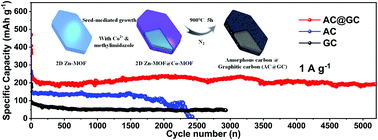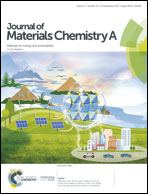Manipulation of 2D carbon nanoplates with a core–shell structure for high-performance potassium-ion batteries†
Abstract
K-ion batteries (KIBs) are very attractive energy storage systems for low-cost and large-scale energy storage, but the development of electrode materials with long cycle life and high rate capability for KIBs remains a major challenge. Here, quasi-two-dimensional (2D) core–shell nanostructured carbon nanoplates are used to design and fabricate a high-performance anode for KIBs. The quasi-2D core–shell amorphous carbon/graphitic carbon nanoplates (AC@GC) exhibit synergistic properties that enable superior K-ion storage performance. Graphitic carbon affords superior conductivity and good stability while amorphous carbon with a high nitrogen content can offer more ion storage sites. Additionally, a 2D nanoporous structure usually offers continuous transport pathways for both ions and electrons. As an anode for KIBs, the AC@GC delivers a high reversible specific capacity (310 mA h g−1 at 100 mA g−1 after 200 cycles), and exhibits outstanding rate properties (170 and 120 mA h g−1 at 2 and 5 A g−1, respectively) and cycling performance (192 mA h g−1 at 1 A g−1 after 5200 cycles). This work suggests that combining a quasi-2D core–shell nanostructure with a hierarchical porous structure is a promising strategy to design long-cycle-life electrodes for KIBs.



 Please wait while we load your content...
Please wait while we load your content...